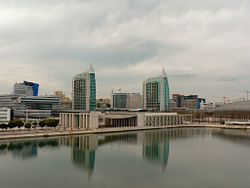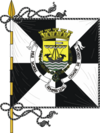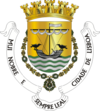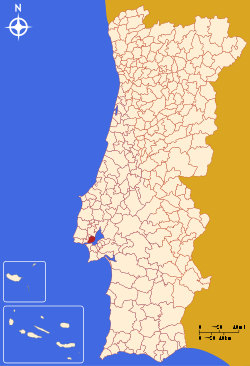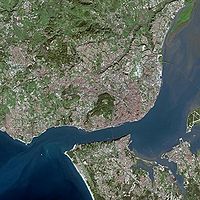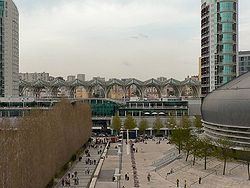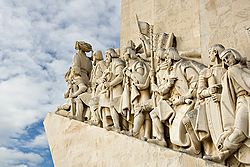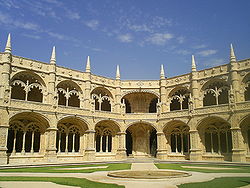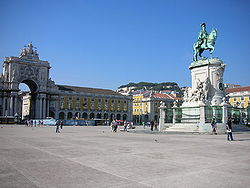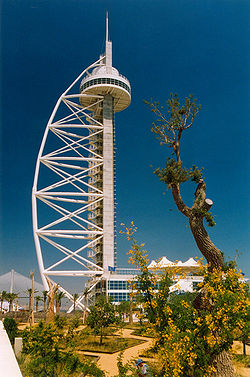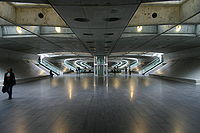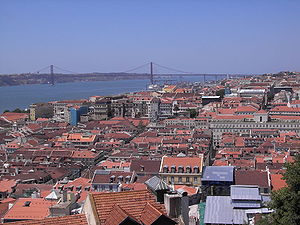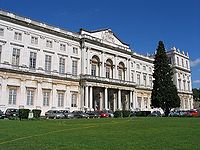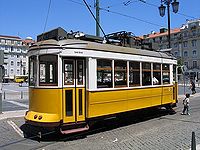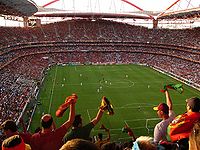Difference between revisions of "Lisbon" - New World Encyclopedia
Mike Butler (talk | contribs) |
Mike Butler (talk | contribs) |
||
| Line 107: | Line 107: | ||
In a raid against Lisbon in 1189, the [[Almohad]] caliph [[Yaqub al-Mansur]] took 3000 female and child captives.<ref>[http://libro.uca.edu/rc/rc1.htm Ransoming Captives in Crusader Spain: The Order of Merced on the Christian-Islamic Frontier]</ref> | In a raid against Lisbon in 1189, the [[Almohad]] caliph [[Yaqub al-Mansur]] took 3000 female and child captives.<ref>[http://libro.uca.edu/rc/rc1.htm Ransoming Captives in Crusader Spain: The Order of Merced on the Christian-Islamic Frontier]</ref> | ||
| − | Lisbon became the capital city of Portugal in 1255 due to its central location in the new Portuguese territory. The first Portuguese [[university]] was founded in Lisbon in 1290 by [[Dinis I of Portugal]] (1279–1325). The university was transferred several times to [[Coimbra]], where it was installed definitively in the 16th century (today's [[University of Coimbra]]). | + | Lisbon became the ''de facto'' capital city of Portugal in 1255 due to its central location in the new Portuguese territory. The first Portuguese [[university]] was founded in Lisbon in 1290 by [[Dinis I of Portugal]] (1279–1325). The university was transferred several times to [[Coimbra]], where it was installed definitively in the 16th century (today's [[University of Coimbra]]). |
During the last centuries of the Middle Ages, the city expanded substantially and became an important trading post with both northern Europe and Mediterranean cities. | During the last centuries of the Middle Ages, the city expanded substantially and became an important trading post with both northern Europe and Mediterranean cities. | ||
Revision as of 20:37, 6 February 2009
| Lisbon Lisboa |
|||
| St. Rafael and St. Gabriel twin towers at Parque das Nações. | |||
|
|||
| Location of Lisbon in Portugal | |||
| Government | |||
| - Mayor | António Costa (elected) PS | ||
|---|---|---|---|
| Area | |||
| - City | 84.8 km² (32.7 sq mi) | ||
| Population | |||
| - City | 564,657 | ||
| - Density | 6,368/km² (16,493/sq mi) | ||
| - Metro | 2,641,006 | ||
| Time zone | GMT (UTC+0) | ||
| Website: http://www.cm-lisboa.pt | |||
Lisbon (Portuguese: Lisboa, IPA: [liʒˈboɐ]) is the capital and largest city of Portugal. Due to its economic output, standard of living, and market size, the Grande Lisboa (Greater Lisbon) subregion is considered the second most important financial and economic center of the Iberian Peninsula.[1] It is also the political center of the country, as seat of government and residence of the Head of State.
Lisbon was under Roman rule from 205 B.C.E., when it was already a 1000-year-old town. Julius Caesar made it a municipium called Felicitas Julia, adding to the name Olissipo. Ruled by a series of Germanic tribes from the 5th century, it was captured by Moors in the 8th century. In 1147, the Crusaders under Afonso Henriques reconquered the city for the Christians and since then it has been a major political, economic and cultural center of Portugal. The municipal holiday is June 13, St. Anthony's Day.
Geography
Several theories for the origin of Lisbon's name are that the city might have been named Allis Ubbo or "safe harbor" in Phoenician, or that it took its name from the pre-Roman name of the River Tagus, Lisso or Lucio.
Lisbon is the westernmost capital in mainland Europe. It is located in the west of the country, on the Atlantic Ocean coast at the point where the river Tagus flows into the Atlantic Ocean.
The city occupies an area of 84.8 km² (33 sq mi). The city boundaries, unlike those of most major cities, are narrowly defined around the historical city perimeter. This gave rise to the existence of several administratively defined cities around Lisbon, such as Amadora, Queluz, Cacém, Odivelas, Loures, Sacavém, Almada, Barreiro, Seixal and Oeiras, which are in fact part of the metropolitan perimeter of Lisbon.
The western side of the city is mainly occupied by the Monsanto Forest Park, one of the largest urban parks in Europe with an area close to 10 square kilometres (almost 4 sq mi).
Elevation
Lisbon has a warm climate that is strongly influenced by the Gulf Stream, giving it one of the mildest climates in Europe. Winters are wet and windy, with the average maximum daytime temperature in January of 57.2°F (14°C). On sunny summer days, the temperature reaches an average maximum of around 82.4°F (28°C) in August. Annual rainfall is 28 inches (700mm), spread over 100 rainy days, mostly from October to April.
Rivers and canals Size – land area, size comparison Environmental issues Districts
History
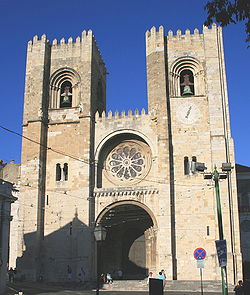
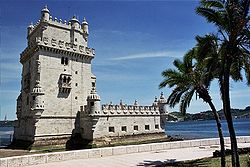
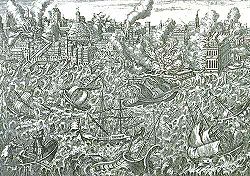
Iberian-related peoples lived in the Lisbon region during the Neolithic period, around 4500 B.C.E. Religious megaliths called dolmens and menhirs from this period still survive in the countryside around the city. The valley in which the center of Lisbon now lies was then a forked branch of the Tagus River.
The Indo-European Celts invaded after the first millennium B.C.E. and intermarried with the Pre-Indo-European population, giving a rise to Celtic-speaking local tribes such as the Cempsi.
Phoenician remains from the eighth century B.C.E. were found beneath the Mediaeval Sé de Lisboa (Lisbon See), or main Cathedral of the modern city. The magnificent harbour provided by the estuary of the river Tagus made it an ideal spot for a settlement to provide foodstuffs to Phoenician ships travelling to the tin islands (modern Isles of Scilly) and Cornwall.
The Greeks knew Lisbon as Olissipo and "Olissipona", a name they thought was derived from Ulysses, though this was a folk etymology. According to an Ancient Greek myth, the hero founded the city after he left Troy, and departed to the Atlantic to escape the Greek coalition.
Later on, the Greek name was corrupted in vulgar Latin to Olissipona. Some of the native gods worshiped in Lisbon were Aracus, Carneus, Bandiarbariaicus and Coniumbricenses.
Roman control
The area was under Roman control from 205 B.C.E. to about 409 C.E. Julius Caesar (100 B.C.E.- 44 B.C.E.), made the settlement a municipium, and named it Felicitas Julia. During the time of Augustus (63 B.C.E.–14 C.E.), the Romans built a great Theatre; the Cassian Baths underneath the current Rua da Prata; Temples to Jupiter, Diana, Cybele, Tethys and Idae Phrygiae (an uncommon cult from Asia Minor), besides temples to the emperor; a large necropolis under Praça da Figueira; a large Forum and other buildings such as insulae (multi-storied apartment buildings) in the area between the modern Castle hill and Downtown.
Economically, Olissipo was known for its garum, a sort of fish sauce highly prized by the elites of the Empire and exported in Amphorae to Rome and other cities. Wine, salt and its famously fast horses were also exported. The city became prosperous through suppression of piracy, which allowed a boom in the trade with the newly Roman provinces of Britannia (particularly Cornwall) and the Rhine, and through the introduction of Roman culture to the tribes living by the river Tagus in the interior of Hispania.
A broad road connected Olissipo to Western Hispania's two other large cities, Bracara Augusta (today's Portuguese Braga), and Emerita Augusta, the capital of Lusitania (now Mérida in Spain).
Olissipo was a centre for the dissemination of Christianity. Its first attested Bishop was St Potamius (c. 356), and martyrs during Emperor Diocletian's persecutionss (303–311) included Maxima, Verissimus, and Julia.
Olissipo was invaded by the Sarmatian Alans and the Germanic Vandals, who controlled the region from 409 to 429. The Germanic Suebi, who established a kingdom in Gallaecia (modern Galicia and northern Portugal), with capital in Bracara Augusta (Braga), from 409 to 585, also controlled the region of Lisbon for long periods of time.
In 585 the Suebi kingdom was included in the Germanic Visigothic kingdom of Toledo, that comprised all of the Iberian Peninsula. Lisbon was then called Ulishbona.
Moorish invasion
The Muslims of North Africa (Moors) took Lisbon around 711 when they overran the Iberian Peninsula. The Moors, who stayed for 433 years, called the city al-ʾIšbūnah and built numerous mosques, houses, and a new city wall, named the Cerca Moura. Arabic was the official language. Islam was the official religion, although Christians could keep their religion but required to pay the jizyah.
The Reconquista
In 1147, as part of the Reconquista, a period of 800 years during which Christian kingdoms succeeded in retaking the Iberian Peninsula from the Muslims, crusader knights led by Afonso I of Portugal (1109–1185), besieged and reconquered Lisbon. Arabic lost its place in everyday life. Any remaining Muslim population were gradually converted to Roman Catholicism, or expelled, and the mosques were turned into churches. Lisbon had a population of 154,000.
Capital city
Lisbon received its first ''foral'' in 1179. A foral was a royal document to establish a concelho (Council) and regulate its administration, borders and privileges. As a result, the population would become directly and exclusively under the dominion and jurisdiction of the crown,
In a raid against Lisbon in 1189, the Almohad caliph Yaqub al-Mansur took 3000 female and child captives.[2]
Lisbon became the de facto capital city of Portugal in 1255 due to its central location in the new Portuguese territory. The first Portuguese university was founded in Lisbon in 1290 by Dinis I of Portugal (1279–1325). The university was transferred several times to Coimbra, where it was installed definitively in the 16th century (today's University of Coimbra).
During the last centuries of the Middle Ages, the city expanded substantially and became an important trading post with both northern Europe and Mediterranean cities.
Vasco da Gama (1460 or 1469 –1524) led a Portuguese fleet of four ships to India from Lisbon in 1497, one of numerous Portuguese expeditions of the Age of Discovery departing from Lisbon during the 15th to 17th centuries.
The city became the European hub of commerce with Africa, India, the Far East and, later, Brazil, exploring riches like spices, slaves, sugar, textiles and other goods. The first Portuguese census in 1527 counted 65,000 inhabitants in Lisbon, a considerable number of whom became rich.
Under the rule of King Manuel I (1495–1521) Portugal developed Manueline architecture, that celebrated the voyages of discovery, Manuel, and God. The city was endowed with larger and more luxurious buildings. The Belém Tower and the Jerónimos Monastery, both of which were declared World Heritage Sites by UNESCO.
Portugal lost its independence to Spain in 1580 after a succession crisis, and the 1640 revolt that restored the Portuguese independence took place in Lisbon (see Philip III of Portugal). In the early 18th century, gold from Brazil allowed King John V to sponsor the building of several Baroque churches and theatres in the city.
Earthquake
The Great Lisbon Earthquake struck on November 1, 1755, at around 9:40 in the morning.[3] The earthquake was followed by a tsunami and fires, which caused near-total destruction of Lisbon, and adjoining areas. Geologists estimated the Lisbon earthquake approached magnitude 9 on the Richter scale, with an epicenter in the Atlantic Ocean about 200 km (120 mi) west-southwest of Cape St. Vincent. Estimates place the death toll in Lisbon, after the earthquake, tsunami, and fires that blazed for days, at around 60,000 people,[4], and more than 12,000 buildings were destroyed, making it one of the most destructive earthquakes in history.
The city was rebuilt largely according to the plans of Prime Minister Sebastião José de Carvalho e Melo, the 1st Marquess of Pombal (1699–1782); hence the designation of the lower town as Baixa Pombalina (Pombaline Downtown). Instead of rebuilding the medieval town, Pombal decided to demolish the earthquake ruins and rebuild the downtown following modern urban rules.
Invasion, revolution
Lisbon alternated between French and British control during the Peninsular War of the early 1800s. Troops of Napoléon Bonaparte (1769–1821) invaded Portugal in 1807, sending Prince-Regent João (future John VI) and his family in flight to Rio de Janeiro in Brazil. Rio replaced Lisbon as the capital of the Portuguese empire from 1808 to 1821.
Ten years of revolutionary outbursts in Lisbon followed as liberal constitutionalists and absolutists fought over succession to the throne.
In 1879, a new main street, the Avenida da Liberdade was opened, replacing a previous public garden. The six-lane carriageway had wide blue mosaic sidewalks with palms, fountains, ponds stocked with goldfish and swans, and outdoor cafés beneath the trees. By 1885, Lisbon covered 20,378 acres (8,250 hectares), and had a population of 300,000.
Lisbon was the centre of the republican coup of October 5, 1910 which instated the Portuguese Republic. Previously, it was also the stage of the assassination of Carlos I of Portugal, on February 1, 1908.
António de Oliveira Salazar (1889-1970) took control of the near-bankrupt country in 1932, and established an authoritarian corporate state until his retirement in 1968.
During World War II Lisbon was one of the very few neutral, open European Atlantic ports, a major gateway for refugees to the U.S. and a spy nest.
In 1974, Lisbon was the central destination point of the Carnation Revolution maneuvers, the end of the Portuguese Corporative Regime (Estado Novo).
In 1988, a fire near the historical centre of Chiado greatly disrupted normal life in the area for about 10 years.
In 1994, Lisbon was the European Capital of Culture.
Expo '98 was held in Lisbon. The timing was intended to commemorate the 500th anniversary of Vasco da Gama's sea voyage to India.
Government
Portugal is a parliamentary representative democratic republic, in which the president, who is chief of state and is directly elected to a five-year term, appoints the prime minister, who is head of government, and council of ministers, according to assembly election results. There is also a council of state, which is a presidential advisory body composed of six senior civilian officers. The unicameral assembly of the republic (Assembleia da Republica) has 230 members who are elected by popular vote to serve four-year terms.
Portugal consists of 308 municipalities (Portuguese singular/plural: concelho/concelhos), which are subdivided into more than 4000 parishes (freguesia/freguesias). Municipalities in continental Portugal are gathered in 18 Districts,
Lisbon is the seat of the district of Lisbon and capital of the Lisbon region. There are 53 freguesias (civil parishes) in Lisbon:
Lisbon is divided into historical "bairros" with no clearly defined boundaries, such as Amoreiras, Bairro Alto, Bica, Alfama, Mouraria, Avenidas Novas, Intendente, Chelas and Lapa.
Unlike most capital cities, Lisbon's status as the capital of Portugal has never been granted or confirmed officially – by statute or in written form. Its position as the capital has formed through constitutional convention, making its position as de facto capital a part of the Constitution of Portugal.
Economy
Portugal has become a diversified and increasingly service-based economy since joining the European Community in 1986. Over the two decades to 2009, successive governments have privatized many state-controlled firms and liberalized key areas of the economy, including the financial and telecommunications sectors. Gross domestic product per capita, estimated at $22,000 in 2008, stands at roughly two-thirds of the European Union average. A poor educational system, in particular, has been an obstacle to greater productivity and growth. [5]
The Lisbon region is the wealthiest region in Portugal and it is well above the European Union's GDP per capita average – it produces 45 percent of the Portuguese GDP. Portugal's per capita GDP was.
Financial and business services sector Tourism Manufacturing Transport: Road, rail, air, sea The city is a hub for Germany’s and Europe’s high-speed passenger rail network. Autobahns radiate from Cologne's ring road. Cologne's international airport is Cologne Bonn Airport, also called Konrad Adenauer Airport. The Rhine harbor is one of the larger inland ports in Germany. Public transport within the city includes buses, a subway system, and the Rheinseilbahn aerial tramway crossing the Rhine. Cologne has pavement-edge cycle lanes linked by cycle priority crossings.
Transportation in Lisbon is more charming than in most cities. Much is owed to its geography; much of Lisbon has been built on its seven hills. No visit to Lisbon is complete without riding the 1930s trams. The greatest attractions, though, are the funiculars, of which there are three. These are Elevador da Glória, Elevador da Bica, and Elevador da Lavra. Perhaps the most picturesque is the Elevador da Bica, which passes through a charming residential neighborhood just below Bairro Alto.[6][7]
The Lisbon region is the wealthiest region in Portugal and it is well above the European Union's GDP per capita average – it produces 45% of the Portuguese GDP. Lisbon's economy is based primarily on the tertiary sector. Most of the headquarters of multinationals operating in Portugal are concentrated in the Grande Lisboa subregion, specially in the Oeiras municipality. Lisbon Metropolitan Area is heavily industrialized, especially the south bank of the Tagus river (Rio Tejo).
The country's chief seaport and featuring one of the largest and most sophisticated regional markets within the Iberian Peninsula, Lisbon and its heavily populated surroundings, are also developing as an important financial center and a dynamic technological hub.
Lisbon has the largest and most developed mass media sector of Portugal, and is home to several related companies ranging from leading television networks and radio stations to major newspapers.
The Euronext Lisbon stock exchange, part of the pan-European Euronext system together with the stock exchanges of Amsterdam, Brussels and Paris, is tied with the New York Stock Exchange since 2007, forming the multinational NYSE Euronext group of stock exchanges.
Lisbon's public transport network is extremely far-reaching and reliable and has its Metro as its main artery, connecting the city centre with the upper and eastern districts, and now reaching the suburbs. Ambitious expansion projects will increase the network by almost one third, connecting the airport, and the northern and western districts. Bus, funicular and tram services have been supplied by the Companhia de Carris de Ferro de Lisboa (Carris), for over a century.
A traditional form of public transport in Lisbon is the tram. Originally introduced in the 19th century, the trams were originally imported from the U.S. and called americanos. The original trams can still be seen in the Museu da Carris (the Public Transport Museum) (Carris). Other than on the modern Line 15, the Lisbon tramway system still employs small (four wheel) vehicles of a design dating from the early part of the twentieth century. These distinctive yellow trams are one of the tourist icons of modern Lisbon, and their size is well suited to the steep hills and narrow streets of the central city.
There are other commuter bus services from the city: Vimeca ([8]), Rodoviaria de Lisboa ([9]), Transportes Sul do Tejo ([10]), Boa Viagem ([11]), Barraqueiro ([12]) are the main ones, operating from different terminals in the city.
There are four commuter train lines departing from Lisbon: the Cascais, Sintra and Azambuja lines (operated by Comboios de Portugal (CP)), as well as a fourth line to Setúbal (operated by Fertagus) crossing the Tagus river over the 25 de Abril Bridge. A separate CP line to Setúbal ends at the southern bank of the Tagus and requires ferry transfer to reach Lisbon. The major railway stations are Santa Apolónia, Rossio, Gare do Oriente and Cais do Sodré.
The city does not offer a light rail service (tram line 15, although running with new and faster trams does not fall onto this category), but there are plans to build some lines with this service around the city (but not into the city itself).
The city is connected to the far side of the Tagus by two important bridges:
- The 25 de Abril Bridge, inaugurated (as Ponte Salazar) on August 6, 1966, and later renamed after the date of the Carnation Revolution, was the longest suspension bridge in Europe and although made by the same engineers as the Golden Gate Bridge in San Francisco, it is not, as thought by some, a replica (the Golden Gate Bridge does not have X braces).
- The Vasco da Gama Bridge, inaugurated on May 1998 is, at 17.2 km (10.7 mi), the longest bridge in Europe.
Another way of crossing the river is by taking the ferry. The main company is Transtejo ([13]), which operates from different points in the city to Cacilhas, Seixal, Montijo, Porto Brandão and Trafaria and the other company is Soflusa ([14]), operating one only line to Barreiro.
Lisbon is connected to its suburbs and the rest of Portugal by an extensive motorway network. There are three circular motorways around the city; the 2ª Circular, the CRIL and the CREL.
The Portela Airport is located within the city limits. TAP and Portugalia have their hubs here and the flights available are mostly to Europe, Africa and America.
Demographics
Its municipality, which matches the city proper excluding the larger continuous conurbation, has a municipal population of 564,477[15] in 84.8 km² (33 sq mi), while the Lisbon Metropolitan Area in total has around 2.8 million inhabitants, and 3.34 million people live in the broader agglomeration of Lisbon Metropolitan Region (includes cities ranging from Leiria to Setúbal).[16] Race/ethnicity - historical background of ethnic groups Language Religion Colleges and universities
There are three major public universities in Lisbon: the University of Lisbon (Lisbon's oldest university in operation, founded in 1911, also called the Classic University of Lisbon), the Technical University of Lisbon (founded in 1930) and the New University of Lisbon (founded in 1973), providing degrees in all academic disciplines. There is also one state-run university institute – the ISCTE, and a polytechnic institute – the Polytechnical Institute of Lisbon.
Major private institutions of higher education include the Portuguese Catholic University, as well as the Lusíada University, the Universidade Lusófona, and the Universidade Autónoma de Lisboa, among others.
The total number of enrolled students in higher education in Lisbon was, for the 2007-2008 school year, of 125,867 students, of whom 81,507 in the Lisbon's public institutions[17].
The population of the city proper was 564,477 and the metropolitan area (Lisbon Metropolitan Area) was 2,800,000 according to the Instituto Nacional de Estatística[18] (National Institute of Statistics). The Lisbon Metropolitan Area coincides with two NUTS II units, Grande Lisboa (Greater Lisbon), in the northern bank of the Tagus, and Península de Setúbal (Setúbal Peninsula), to the south, which are the two subregions of Região Lisboa (Lisbon Region). The population density of the city itself is
- REDIRECT Template:Convert/PD/km2.
Like most big cities, Lisbon is surrounded by many satellite cities. It is estimated that more than one million people enter Lisbon every day from the outskirts. Cascais and Estoril are among the most interesting neighbouring towns for night life. Beautiful palaces, landscapes and historical sites can be found in Sintra and Mafra. Other major municipalities around Lisbon include Amadora, Oeiras, Odivelas, Loures, Vila Franca de Xira and, in the south bank of the Tagus river estuary, Almada, Barreiro and Seixal.
Lisbon is ranked number 1 in the Portuguese most livable cities survey of living conditions published yearly by Expresso.[19]
| 1801 | 1849 | 1900 | 1930 | 1960 | 1981 | 1991 | 2001 | 2004 |
|---|---|---|---|---|---|---|---|---|
| 203.999 | 174.900 | 350.919 | 591.939 | 801.155 | 807.937 | 663.394 | 564.657 | 529.485 |
Culture and sights
The city of Lisbon is rich in architecture; Romanesque, Gothic, Manueline, Baroque, Traditional Portuguese, Modern and Post-Modern constructions can be found all over the city. The city is also crossed by great boulevards and monuments along these main thoroughfares, particularly in the upper districts; notable among these are the Avenida da Liberdade (Liberty Avenue), Avenida Fontes Pereira de Melo, Avenida Almirante Reis and Avenida da República (Republic Avenue). The most famous museums in Lisbon are the Museu Nacional de Arte Antiga (National Museum of Ancient Art), the Museu do Azulejo (Museum of Portuguese-style Tile Mosaics), the Museu Calouste Gulbenkian (Calouste Gulbenkian Museum, containing varied collections of ancient and modern art), the Lisbon Oceanarium (Oceanário de Lisboa, the second largest in Europe), the Museu Nacional do Traje e da Moda (National Museum of Costume and Fashion), the Berardo Collection Museum (Modern Art) at the Belém Cultural Center, the Museu Nacional dos Coches (National Coach Museum, containing the largest collection of royal coaches in the world), the Museu da Farmácia (Pharmacy Museum) and the Lisbon Orient Museum.
Lisbon's opera house, the Teatro Nacional de São Carlos, hosts a relatively active cultural agenda, mainly in autumn and winter. Other important theatres and musical houses are the Centro Cultural de Belém, the Teatro Nacional D. Maria II and the Gulbenkian Foundation.
The monument to Christ the King (Cristo Rei) stands on the left side of the river, in Almada. With open arms, overlooking the whole city, it resembles the Corcovado monument in Rio de Janeiro, and was built after World War II, as thanks for Portugal's being spared the horrors and destruction of the war.
Every June there are 5 days of popular street celebrations in memory of a saint born in Lisbon – Anthony of Lisbon (or Santo António). Saint Anthony, also known as Saint Anthony of Padua, was a wealthy Portuguese bohemian who was canonised and made Doctor of the Church after a life preaching to the poor, simpler people. Although Lisbon’s patron saint is Saint Vincent, whose remains are in the Lisbon Cathedral, there are no festivities associated with him.
Parque Eduardo VII is the second largest park of the city after Parque Florestal de Monsanto, prolonging the main avenue (Avenida da Liberdade). Originally named Parque da Liberdade, was after renamed Park Edward VII of England who visited Lisbon in 1903, it includes a large variety of plants in a winter garden (Estufa Fria).
Lisbon is home every year to the Lisbon Gay & Lesbian Film Festival,[20] the Lisboarte,[21] the DocLisboa – Lisbon International Documentary Film Festival,[22] the Arte Lisboa – Contemporary Art Fair,[23] the Festival of the Oceans,[24] the International Organ Festival of Lisbon,[25] the MOTELx – Lisbon International Horror Film Festival,[26] the Lisbon Village Festival,[27] the Festival Internacional de Máscaras e Comediantes, the Lisboa Mágica – Street Magic World Festival, the Lisbon Book Fair,[28] the Peixe em Lisboa – Lisbon Fish and Flavours,[29] the Lisbon International Handicraft Exhibition,[30] the Lisbon Photo Marathon, the IndieLisboa – International Independent Film Festival,[31] the Alkantara Festival,[32] the Temps d´Images Festival[33] and the Jazz in August festival.[34]
Lisbon is also home to the Lisbon Architecture Triennial,[35] the Moda Lisboa (Fashion Lisbon),[36] ExperimentaDesign – Biennial of Design[37] and LuzBoa – Biennial of Light.[38]
Alfama district
The oldest district of the city is Alfama, close to the Tagus, which has made it relatively unscathed through the various earthquakes. The Castle of São Jorge and the Lisbon Cathedral are located in this area. Other attractions include:
- Monastery of São Vicente de Fora
- Church of Santo António
- Santa Luzia Belvedere
- Largo das Portas ao Sol
Baixa
The heart of the city is the Baixa (Downtown) or city centre; this area of the city is being considered for UNESCO World Heritage Site status. The Baixa is organised in a grid system and a network of squares built after the 1755 Lisbon earthquake, which levelled a great portion of the medieval city. Other monuments in this area include:
- Praça do Comércio (Commerce Square) and Rossio Square the oldest and historically most important squares in Lisbon
- Church of Nossa Senhora da Conceição Velha which has a beautiful manueline façade
- Church of São Domingos
- Restauradores Square
- Elevador de Santa Justa, an elevator (lift) in Gothic revival style, built around 1900 to connect the Baixa and Chiado.
Chiado
The trendiest area in the city, Chiado is home to cafes, galleries, bookshops and relevant examples of 18th century religious architecture. Attractions include:
- Basilica dos Mártires
- Church of Nossa Senhora do Loreto
- Church of Corpo Santo
- Brasileira Cafe
- Carmo Convent
- Museu do Chiado, which houses most important works of Portuguese contemporary art
- The richly-decorated Church of São Roque is located nearby.
Bairro Alto
Bairro Alto (literally upper quarter in Portuguese) is an area of central Lisbon. It functions as a residential, shopping and entertainment district. Today, the Bairro Alto is the heart of Lisbon's youth and of the Portuguese capital's nightlife. Lisbon's Punk, Gay, Metal, Goth, Hip Hop and Reggae scenes, all have the Bairro as their home, due to the number of clubs and bars dedicated to each of them. The fado, Portugal's national song, still survives in the new Lisbon's nightlife. The crowd is a mix of local and tourist, straight and gay, and almost anything else imagined.
Estrela
The Baroque-Neoclassical Estrela Basilica is the main attraction of this district. The Parliament and the Prazeres Cemetery are nearby.
Belém
Along the Rio Tejo (Tagus River), is the historic neighborhood of Belém. Its prime attraction is the grand Jerónimos Monastery. Construction started in 1501, and took 70 years to complete. During its construction, the monastery cost an equivalent of Template:Convert/LoffAyesDbSoff of gold each year. Most of the construction costs were financed through the spice trade. It is a prime example of what is called Manueline architecture, with inspiration brought back from the explorations, as well as being influenced by the Gothic and Renaissance periods. Other attractions within the area are:
- Padrão dos Descobrimentos (Monument of the Discoveries), built in mid-20th century, during Estado Novo dictatorial regime
- Belem Cultural Centre, example of Portuguese contemporary architecture, finished in 1994
- Belem Tower, an ex-libris of the city, built in the 16th century
- Belem Palace, 18th century palace, which is now the official residence of the President of the Republic
- Coach Museum, displaying most relevant and spectuacular carriages from 17th to 19th century.
Gare do Oriente
Gare do Oriente (Orient Station) is one of the main transportation hubs of Lisbon, for trains, metro, buses and taxis. Its glass and steel columns are reminiscent of palms, making the whole structure fascinating to look at (especially in sunlight or when illuminated at night). It was designed by the architect Santiago Calatrava from Valencia (Spain). Cross through the shopping mall just across the street and you are in Parque das Nações (Park of the Nations), site of the 1998 World Expo.
Contemporary events
The Lisbon Agenda was a European Union agreement on measures to revitalize the EU economy, signed in Lisbon in March 2000.
Every March the city hosts the world-famous Lisbon Half Marathon, one of the most attended events of its kind in the world.[citation needed]
It regularly hosts countless other international events including various NATO, European Union and other summits.
In 2004, Portugal hosted the UEFA Euro 2004 football tournament, in which the Portuguese national team lost to Greece in the final.
Rock in Rio, known for being the biggest pop-rock festival in the world with an attendance that can reach 100 000 people, was held in Lisbon three times (2004, 2006 and 2008) and will continue in the city for some years, hosting concerts of many high profile singers and bands, such as Anastacia, Metallica, Shakira, Guns N' Roses, Roger Waters, Britney Spears, Red Hot Chili Peppers, Amy Winehouse and many more.
In January 2006 and 2007, Lisbon was the starting city of the Dakar Rally.
On the 7 July 2007, Lisbon held the ceremony of the "New 7 Wonders Of The World"[39] election, in Luz stadium, with live transmition for millions of people all over the world.
On the 18 and 19 October 2007 Lisbon held the 2007 EU Summit, where agreement was reached regarding the Union governance model. The Treaty of Lisbon was signed on the 13 December 2007.
Sports
The Lisbon sports clubs Sport Lisboa e Benfica (commonly "Benfica") and Sporting Clube de Portugal (commonly "Sporting"), have many sports teams in the highest Portuguese divisions and European competitions. Belenenses, another important club with a great tradition in Portuguese sport, is also from the Portuguese capital.
Football is the most popular sport in Lisbon. Major football clubs include S.L. Benfica, with its home 65,000 seat stadium the UEFA 5-Star Stadium Estádio da Luz (named after the area in which the stadium is situated (Luz) and not, as is popularly believed, 'Stadium of Light'). Benfica has won the UEFA Champions League twice and has appeared in the final seven times. Sporting Clube de Portugal is the other major football team from the city, also having a UEFA 5-Star stadium, 52,000 seat Estádio José de Alvalade stadium. It has won the UEFA Cup Winners Cup once and was the UEFA Cup finalist in the 2004-05 season. Former players from this team include Luís Figo and Cristiano Ronaldo. Belenenses is the third most important football team in the city, having Estádio do Restelo as its home stadium in the Belém neighbourhood of Lisbon. Belenenses holds the distinction of being the first club, other than perennial winners Sporting, Benfica and Porto, to win the Portuguese League, taking the trophy in the 1945-46 season.
Other sports, such as indoor football, handball, basketball and roller hockey are also popular.
There are many other sport facilities in Lisbon, ranging from athletics to sailing to golf to mountain-biking.
Parishes
Gallery
- Torre de Belem 1.JPG
Belém Tower
- TelhadosLisboa1.JPG
Baixa and Lisbon Castle
- Ponte 25 de Abril 20050728.jpg
- TeatroNacionalDMariaII.JPG
Teatro Nacional D. Maria II
- MonumentoRestauradoresLisboa.JPG
Restauradores Square
- Lisbon calcada.jpg
Portuguese pavement
- Aqueduto das Águas Livres (1).jpg
Águas Livres Aqueduct
- Rossio Lisboa 2007.jpg
Rossio Square
- Torre Vasco da Gama 01.JPG
Parque das Nações
- Gare Oriente Lisboa.JPG
Gare do Oriente
- Lisboa - Marquês de Pombal.jpg
Aerial view
- Jeronimos Monastery South.jpg
Jerónimos Monastery
- Lisbon35.jpg
Alfama
- AvLiberdadeLisbon-CCBYSA.jpg
Avenida da Liberdade
- Lisbon05.jpg
Augusta Street
- LisbonChiado2-CCBYSA.jpg
Chiado Square
- Conceiçao Velha - Portal Manuelino.JPG
Conceição Church
- Largo do Camões.jpg
Camões Square
- 22062008lisbondiscoverymark.jpg
Discoveries Mark
- Lisbon (Lisboa) historic elevator Santa Justa Luca Galuzzi 2006.jpg
ReferencesISBN links support NWE through referral fees
- ↑ Competitive Cities in the Global Economy
- ↑ Ransoming Captives in Crusader Spain: The Order of Merced on the Christian-Islamic Frontier
- ↑ Between History and Periodicity: Printed and Hand-Written News in 18th-Century Portuga
- ↑ Pereira (2006), page 5.
- ↑ World Fact Book 2009[1] Retrieved February 6, 2009.
- ↑ [2] Information from Carris, Lisbon transportation company.
- ↑ [3] Details of Lisbon's trams, from Luso Pages
- ↑ http://www.vimeca.pt
- ↑ http://www.rodoviariadelisboa.pt
- ↑ http://www.tsuldotejo.pt
- ↑ http://www.boa-viagem.pt
- ↑ http://www.barraqueirotransportes.pt
- ↑ http://www.transtejo.pt
- ↑ http://www.transtejo.pt
- ↑ UMA POPULAÇÃO QUE SE URBANIZA, Uma avaliação recente - Cidades, 2004 Nuno Pires Soares, Instituto Geográfico Português (Geographic Institute of Portugal)
- ↑ Fernando Nunes da Silva (2005), Alta Velocidade em Portugal, Desenvolvimento Regional, CENSUR, IST
- ↑ http://www.estatisticas.gpeari.mctes.pt/archive/doc/insc07_08__difusao_.xls
- ↑ http://www.ine.pt/
- ↑ Classificação Expresso das melhores cidades portuguesas para viver em 2007, Expresso
- ↑ Official web-site.. Lisbon Gay and Lesbian Film Festival. Retrieved 2006-11-06.
- ↑ http://www.lisboarte.com
- ↑ http://www.doclisboa.org/
- ↑ http://www.artelisboa.fil.pt/
- ↑ http://www.festivaldosoceanos.com/
- ↑ http://www.jmp.pt
- ↑ http://www.motelx.org
- ↑ http://lisbon.villagefestival.net/
- ↑ http://www.feiradolivrodelisboa.pt
- ↑ http://www.peixemlisboa.com
- ↑ http://www.artesanato.fil.pt/
- ↑ http://www.indielisboa.com
- ↑ http://www.alkantara.pt
- ↑ http://www.tempsdimages-portugal.com/
- ↑ http://www.musica.gulbenkian.pt/
- ↑ http://trienal.blogs.sapo.pt
- ↑ http://www.modalisboa.pt/
- ↑ http://www.experimentadesign.pt/
- ↑ http://www.luzboa.com
- ↑ http://www.new7wonders.com/index.php?id=315&L=0
Further reading
- Maxwell, Kenneth. 1995. The making of Portuguese democracy. Cambridge, MA: Cambridge University Press. ISBN 9780521460774
- Pinto, António Costa. 1998. Modern Portugal. Palo Alto, Calif: Society for the Promotion of Science and Scholarship. ISBN 9780930664176
- Wheeler, Douglas L. 1993. Historical dictionary of Portugal. (European historical dictionaries, no. 1.) Metuchen, NJ: Scarecrow Press. ISBN 9780810826960
External links
- World Fact Book 2009 Portugal Retrieved February 6, 2009.
- Câmara Municipal de Lisboa – Official page of the city
- Travel guide to Lisbon from Wikitravel
- Visit Portugal: Lisbon Past and Present – Official page by the Government of Portugal
- Associação de Turismo de Lisboa – Official site of the Lisbon Tourism Association
- OTLIS – Official site of the Lisbon Region Transport Operators Consortium
- Portal das Nações Official site of Parque das Nações in Lisbon
- Lisboa Portal
Credits
New World Encyclopedia writers and editors rewrote and completed the Wikipedia article in accordance with New World Encyclopedia standards. This article abides by terms of the Creative Commons CC-by-sa 3.0 License (CC-by-sa), which may be used and disseminated with proper attribution. Credit is due under the terms of this license that can reference both the New World Encyclopedia contributors and the selfless volunteer contributors of the Wikimedia Foundation. To cite this article click here for a list of acceptable citing formats.The history of earlier contributions by wikipedians is accessible to researchers here:
The history of this article since it was imported to New World Encyclopedia:
Note: Some restrictions may apply to use of individual images which are separately licensed.
